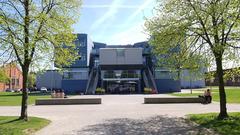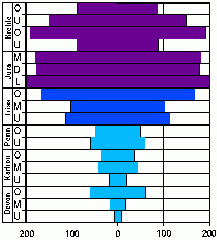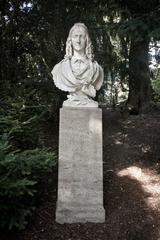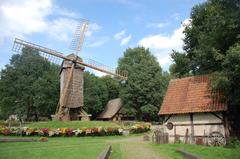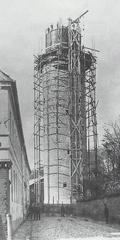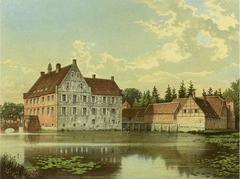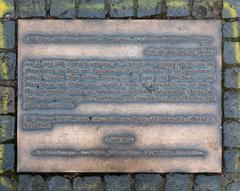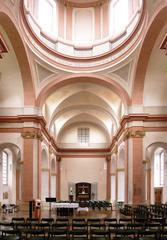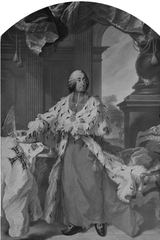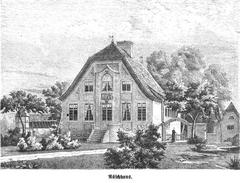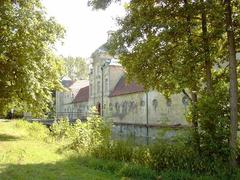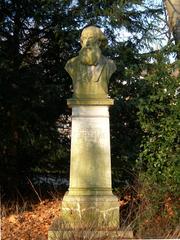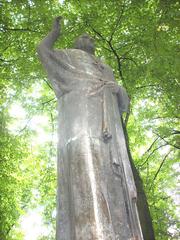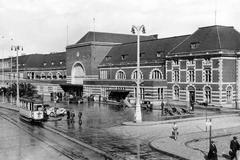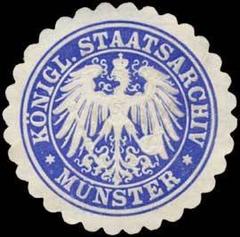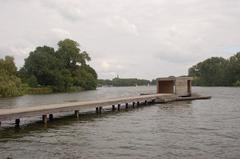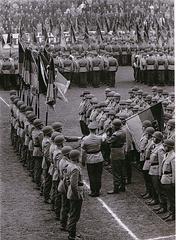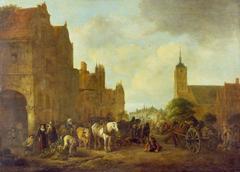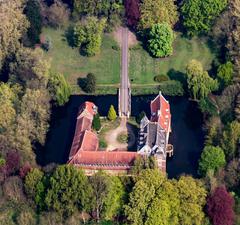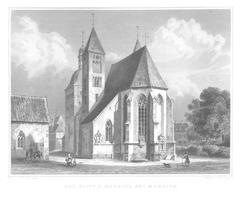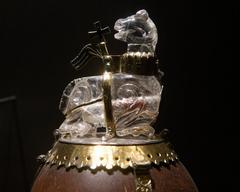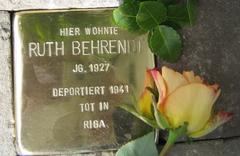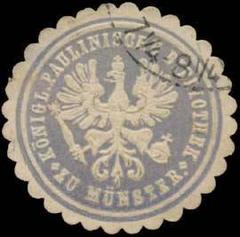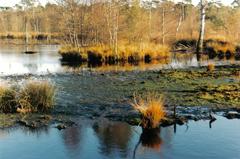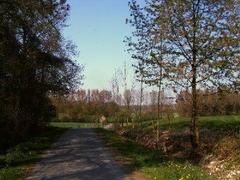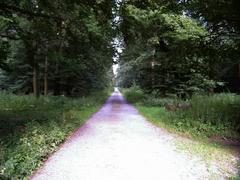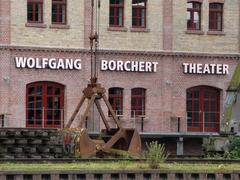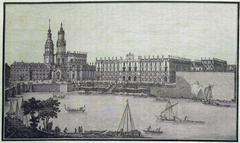Krameramtshaus Münster: Visiting Hours, Tickets, and Historical Significance
Date of Publication: 04/07/2025
Introduction
The Krameramtshaus in Münster, Germany, stands as a remarkable example of late 16th-century Westphalian Renaissance architecture and the city’s rich mercantile heritage. Built in 1589 by the Grocers’ Guild (Krameramt), it occupies a central location near the Prinzipalmarkt and St. Lamberti Church, making it a key focal point in Münster’s Old Town. The Krameramtshaus is celebrated for its ornate stepped brick gables, intricate pilasters, and decorative stonework, which together showcase the prosperity and influence of Münster’s merchant class during the Hanseatic era. Remarkably, the building survived World War II largely intact, maintaining much of its original façade and interior, including the guild’s motto-inscribed fireplace that reflects the era’s values of honor and self-discipline (Stadt Münster, Wiki Münster).
Today, the Krameramtshaus houses the Haus der Niederlande, a dynamic cultural and academic hub dedicated to fostering German-Dutch relations. Visitors can experience rotating exhibitions, attend lectures, and join guided tours that highlight the building’s role in Münster’s economic and social history, as well as its broader European significance. With convenient visiting hours, mostly free admission, and accessibility accommodations, the Krameramtshaus offers a rewarding destination for history buffs, architecture aficionados, and culturally curious travelers alike (Haus der Niederlande, Gütsel.de).
This guide provides detailed information on the Krameramtshaus’s history, architecture, visiting hours, ticketing, accessibility, nearby attractions, and practical tips, ensuring you have everything you need to plan and enjoy your visit.
Historical Overview
Origins and Early Use
Commissioned in 1589 by the influential Krameramt (Grocers’ Guild), the Krameramtshaus initially served as the administrative and social headquarters for Münster’s merchant community. The building’s prominent stepped gables and richly decorated façade were designed to communicate the guild’s wealth and status during Münster’s Hanseatic heyday (Stadt Münster).
Architectural Evolution and Preservation
Throughout the centuries, the Krameramtshaus was periodically renovated, adapting to changing needs while retaining its Renaissance character. Its survival of World War II bombings allowed the preservation of original features, including sandstone elements, timber framing, and the unique guild motto fireplace. Restoration efforts in the 20th and 21st centuries have balanced historical authenticity with modern requirements such as accessibility and infrastructure improvements (Wiki Münster).
Role in Social and Economic Life
As the hub of the Grocers’ Guild, the Krameramtshaus played a central role in regulating local trade, hosting meetings, and organizing social events, which fostered a sense of community among Münster’s merchants. The building is also notable for its historical association with the Peace of Westphalia negotiations, during which it accommodated Dutch envoys in 1648, marking an important moment in European diplomatic history (Wikipedia).
Architectural Highlights
Exterior Design
The Krameramtshaus stands as a quintessential example of Westphalian Renaissance guild architecture, with a prominent stepped brick gable, decorative pilasters, fan-shaped ornaments, and a wrought-iron weather vane. The rear gable, equally elaborate, emphasizes the building’s freestanding character. Red brick and stone accents, together with a robust quarry stone base, provide structural stability and visual impact (Salzstraßenviertel, Wiki Münster).
Interior Spaces
Built over a sturdy stone cellar, the Krameramtshaus features a ground floor that originally served as a warehouse, with spacious halls and thick masonry walls. The upper floor was designed for guild meetings and administration, its centerpiece being a large fireplace with the inscribed motto “Ehr is Dwang gnog” (“Honor is compulsion enough”), a testament to the ethical standards of the merchant class (Wikipedia).
Decorative Elements
The stepped gable’s intricate brickwork and stone embellishments, as well as interior motifs like laurel and oak branches surrounding the guild motto, reflect the Krameramtshaus’s role as both a status symbol and a center of communal values. These features reinforce the ideals of honor and self-governance central to guild life (Salzstraßenviertel).
Adaptive Reuse and Modern Functions
Following the decline of traditional guilds, the Krameramtshaus transitioned into various civic roles, including a period as the city library. Since 1995, it has been home to the Haus der Niederlande, hosting academic institutes, a specialized library of Dutch studies, and a variety of cultural events and exhibitions (Stadt Münster). The careful restoration and adaptive reuse of the building have ensured its continued relevance as both a heritage monument and a living cultural venue (Salzstraßenviertel).
Visiting Information
Opening Hours and Admission
- Monday, Wednesday, Thursday, Friday: 12:00–18:00
- Saturday and Sunday: 10:00–16:00
- Tuesday: Closed
- Public Holidays: Hours may vary; check the Haus der Niederlande website for updates.
Admission to most exhibitions is free. Some special events or exhibitions may require tickets or advance registration. Tickets can be purchased online or at the venue’s information desk.
Accessibility
The Krameramtshaus is partially accessible. The main exhibition spaces are on the ground floor and accessible to wheelchair users, but upper floors may only be reached via stairs due to the building’s historic structure. Visitors with mobility concerns should contact the Haus der Niederlande in advance for specific information (Haus der Niederlande).
Facilities
- Restrooms: Available on-site.
- Cloakroom: Limited storage for coats and bags.
- Wi-Fi: Free in public areas.
- Information Desk: Staff available for visitor assistance and information.
Guided Tours and Educational Programs
Guided tours are regularly offered in German and Dutch, with English-language options available on request or during special events. Tours provide insights into the Krameramtshaus’s architectural features, history, and its role in Münster’s merchant past. Educational workshops and thematic programs are held throughout the year, especially during major exhibitions and anniversaries (Haus der Niederlande events).
Special Events and Exhibitions
In 2025, the Krameramtshaus celebrates the 30th anniversary of the Haus der Niederlande with the exhibition “Niederlande in 3D,” which explores the building’s history and its significance in Dutch-German cultural exchange. The celebration includes panel discussions, readings, open house events, and interactive activities (Haus der Niederlande program). Past exhibitions, such as “Rudolf Breilmann – Von Tunis bis Stonehenge,” highlight the venue’s commitment to showcasing regional and international art (Gütsel.de).
Location and Nearby Attractions
The Krameramtshaus is centrally located at Alter Steinweg 6/7, 48143 Münster, within the historic Old Town. It is within walking distance of:
- Prinzipalmarkt: Münster’s iconic merchant street with arcaded shops.
- St. Lamberti Church: Known for its architecture and historic significance.
- Dominikanerkirche: A Gothic former Dominican church.
- Wochenmarkt Münster: Vibrant open market on Domplatz (Wednesdays and Saturdays).
- Münster Cathedral: A must-see for visitors interested in religious and architectural history.
The area is pedestrian- and bicycle-friendly, with public transport stops nearby at Prinzipalmarkt and Domplatz (ems-radweg.org, The Crazy Tourist).
Visitor Tips
- Photography: Permitted for personal use (no flash).
- Biking: Münster is known for its cycling culture; consider renting a bike to explore.
- Language: Staff speak German and Dutch; English is understood, especially during events.
- Market Days: Visit nearby markets for local crafts and produce.
- Combine Visits: Plan to see multiple attractions in Münster’s Old Town for a full experience.
Practical Information
- Address: Alter Steinweg 6/7, 48143 Münster, Germany
- Website: Haus der Niederlande
- Phone: +49 (0)251 83-29370
- Public Transport: Bus stops at Prinzipalmarkt or Domplatz; Münster Hauptbahnhof is a 15-minute walk.
Sustainability and Responsible Tourism
Münster encourages visitors to use public transport or bicycles, minimize waste, and support local businesses. The Krameramtshaus contributes to sustainable tourism by preserving cultural heritage and promoting cross-border understanding.
Frequently Asked Questions (FAQ)
Q: What are the Krameramtshaus visiting hours?
A: Monday, Wednesday, Thursday, Friday: 12:00–18:00; Saturday and Sunday: 10:00–16:00; closed Tuesdays.
Q: Is there an entrance fee?
A: Admission is free for most exhibitions; some special events may require tickets.
Q: Is the Krameramtshaus wheelchair accessible?
A: The ground floor is accessible; upper floors may have limited access due to the historic nature of the building. Contact the venue for details.
Q: Are guided tours available in English?
A: Yes; English-language tours are available upon request or during special events.
Q: What other attractions are nearby?
A: Prinzipalmarkt, St. Lamberti Church, Wochenmarkt Münster, and Münster Cathedral are all within walking distance.
Summary and Recommendations
The Krameramtshaus is more than a historic guild house; it is a living monument connecting Münster’s mercantile heritage with its vibrant present as a center for culture and academic exchange. Its magnificent Renaissance architecture, historical significance, and role as Haus der Niederlande make it a must-visit for anyone interested in Münster’s past and contemporary cultural life. With central location, mostly free admission, and a diverse program of exhibitions and events, the Krameramtshaus welcomes all visitors seeking to immerse themselves in the city’s unique heritage.
For up-to-date information, event schedules, and to plan your visit, consult the Haus der Niederlande website and consider downloading the Audiala app for an interactive audio guide and map of Münster’s historical sites.
Sources and Further Reading
- Stadt Münster. Krameramtshaus Münster: Visiting Hours, Tickets, and Historical Insights. (Stadt Münster)
- Wiki Münster. Krameramtshaus. (Wiki Münster)
- Gütsel.de. Krameramtshaus Münster: Rudolf Breilmann – Von Tunis bis Stonehenge Exhibition Details. 2024-2025. (Gütsel.de)
- Haus der Niederlande. Official Website & Visitor Information. University of Münster. (Haus der Niederlande)
- Wikipedia. Haus der Niederlande. (Wikipedia)
